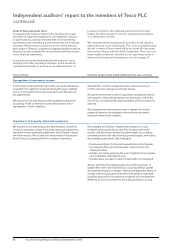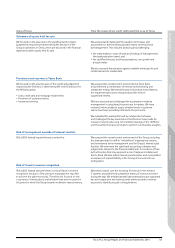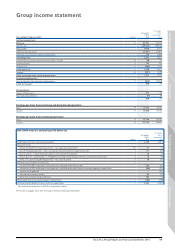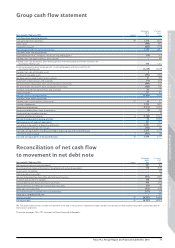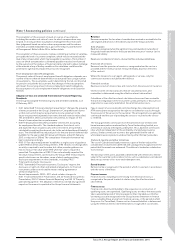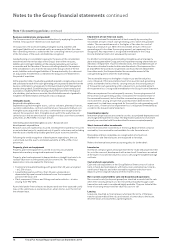Tesco 2014 Annual Report Download - page 78
Download and view the complete annual report
Please find page 78 of the 2014 Tesco annual report below. You can navigate through the pages in the report by either clicking on the pages listed below, or by using the keyword search tool below to find specific information within the annual report.
Note 1 Accounting policies continued
The calculation of the provision is based on a series of assumptions
including the number and value of cases for which compensation may
be paid. In arriving at these assumptions management have exercised
their judgement based on earlier redress programmes and the redress
estimates provided independently as part of the industry wide Scheme
of Arrangement. Refer to Note 24 for further details.
The calculation of these provisions involves estimating a number of variables,
principally the level of customer complaints which may be received and the
level of any compensation which may be payable to customers. The number of
cases on which compensation is ultimately payable may also be influenced
by the outcome of the analysis of historical claims referred to above. A change
in the estimate of any of the key variables in this calculation could have the
potential to significantly impact the provisions recognised.
Post-employment benefit obligations
The present value of the post-employment benefit obligations depends ona
number of factors that are determined on an actuarial basis using anumber
of assumptions. The assumptions used in determining the netcost (income)
for pensions include the discount rate. Any changes in these assumptions
will impact the carrying amount of post-employment benefit obligations.
Key assumptions for post-employment benefit obligations are disclosed in
Note 26.
Adoption of new and amended International Financial Reporting
Standards
The Group has adopted the following new and amended standards as of
24 February 2013:
• IAS 1 (amended) ‘Financial statement presentation’ changes the grouping
of items presented in the Group’s Statement of Comprehensive Income
so that items which may be reclassified to income statement in the
future are presented separately from items that will never be reclassified.
The amendment affects presentation only and has no impact on the
Group’s financial position or performance.
• IAS 19 ‘Employee benefits (Revised 2011)’ amends the accounting
for employment benefits. The standard replaces the interest costs
and expected return on plan assets with a net interest amount that is
calculated by applying the discount rate to the net defined benefit liability/
asset. The amendment has reduced profit for the year (net of deferred tax)
by £86m for the year ended 22 February 2014 (year ended 23 February
2013: a reduction of £96m). The comparative financial information has
been restated accordingly.
• IFRS 13 ‘Fair value measurement’ establishes a single source of guidance
under IFRS for all fair value measurements. IFRS 13 does not change when
an entity is required to use fair value, but rather provides guidance on
how to measure fair value under IFRS when fair value is required or
permitted. The application of IFRS 13 has not materially impacted the
fair value measurements carried out by the Group. IFRS 13 also requires
specific disclosures on fair values, some of which replace existing
disclosure requirements in other standards, including IFRS 7
‘Financial Instruments: Disclosures’.
• IFRS 7 (amended) ‘Financial instruments: Disclosures’ requires the
disclosure on rights of offset and related arrangements for financial
instruments under an enforceable master netting agreement or
similar arrangements.
• Annual Improvements 2009 – 2011 which includes changes to
IAS 1 ‘Financial Statement Presentation’, IAS 32 ‘Financial Instruments:
Presentation, IAS 34 ‘Interim Financial Reporting’ and IAS 16 ‘Property,
plant and equipment’. The adoption of these has not had any significant
impact on the amounts reported in the Group financial statements.
Revenue
Revenue comprises the fair value of consideration received or receivable for the
sale of goods and services in the ordinary course of the Group’s activities.
Sale of goods
Revenue is recognised when the significant risks and rewards of ownership of
the goods have transferred to the buyer and the amount of revenue can be
measured reliably.
Revenue is recorded net of returns, discounts/offers and value added taxes.
Provision of services
Revenue from the provision of services is recognised when the service is
provided and the revenue can be measured reliably, based on the terms
of the contract.
Where the Group acts as an agent selling goods or services, only the
commission income is included within revenue.
Financial services
Revenue consists of interest, fees and income from the provision of insurance.
Interest income on financial assets that are classified as loans and
receivables is determined using the effective interest rate method.
Calculation of the effective interest rate takes into account fees receivable
that are an integral part of the instrument’s yield, premiums or discounts on
acquisition or issue, early redemption fees and transaction costs.
Fees in respect of services (credit card interchange fees, late payment and
ATM revenue) are recognised as the right to consideration accrues through
the provision of the service to the customer. The arrangements are generally
contractual and the cost of providing the service is incurred as the service
is rendered.
The Group generates commission from the sale and service of motor and
home insurance policies underwritten by Tesco Underwriting Limited, or in
a minority of cases by a third party underwriter. This is based on commission
rates which are independent of the profitability of underlying insurance
policies. Similar commission income is also generated from the sale of
white label insurance products underwritten by other third party providers.
Clubcard, loyalty and other initiatives
The cost of Clubcard and loyalty initiatives is part of the fair value of the
consideration received and is deferred and subsequently recognised over the
period that the awards are redeemed. The deferral is treated as a deduction
from revenue.
The fair value of the points awarded is determined with reference to the fair
value to the customer and considers factors such as redemption via Clubcard
deals versus money-off-in-store and redemption rate.
Rental income
Rental income is recognised in the period in which it is earned, in accordance
with the terms of the lease.
Finance income
Finance income, excluding income arising from financial services, is
recognised in the period to which it relates using the effective interest
ratemethod.
Finance costs
Finance costs directly attributable to the acquisition or construction of
qualifying assets are capitalised. Qualifying assets are those that necessarily
take a substantial period of time to prepare for their intended use. All other
borrowing costs are recognised in the Group Income Statement in finance
costs, excluding those arising from financial services, in the period in which
they occur. For Tesco Bank, finance cost on financial liabilities is determined
using the effective interest rate method and is recognised in cost of sales.
Other information
Governance Financial statementsStrategic report
Tesco PLC Annual Report and Financial Statements 2014 75



